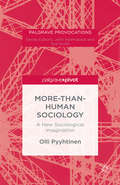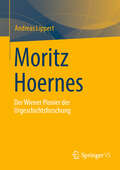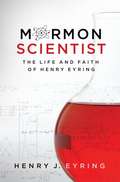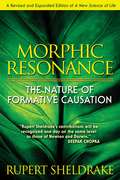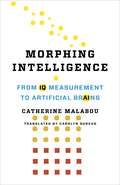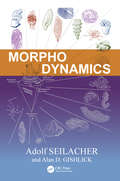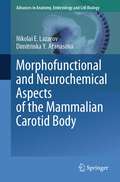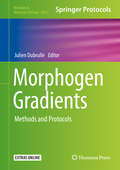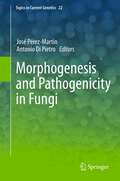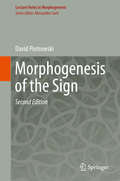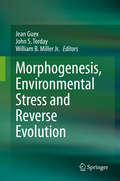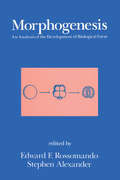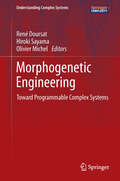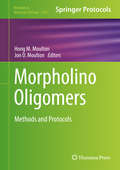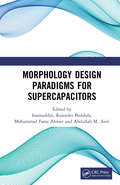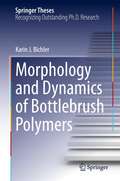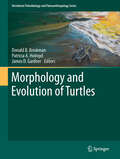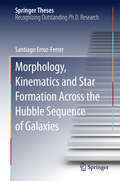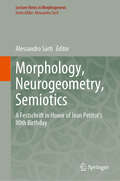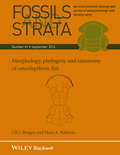- Table View
- List View
More-than-Human Sociology: A New Sociological Imagination
by O. PyyhtinenMore-than-Human Sociology is a call for a bolder, more creative sociology. Olli Pyyhtinen argues that to make sociology responsive to life in the 21st century we need a new sociological imagination, one that addresses connectivity, understands the world in which we live as both a human and non-human world, and is sensitive to the multiple scales on which things exist. A fresh and innovative take on the promise of sociology, this book will appeal to scholars and students both within sociology and the social sciences more broadly.
Moritz Hoernes: Pionier der Urgeschichtsforschung
by Andreas LippertDer Band ist eine Biografie des ersten Lehrkanzelinhabers für Prähistorische Archäologie im deutschen Sprachraum. Nach einer längeren Zeit von Forschungen in Bosnien und der Herzegowina fand Hoernes eine Anstellung in der Prähistorischen Sammlung des Naturhistorischen Hofmuseums in Wien. Hier erst entschied er sich für urgeschichtliche Forschungen. Er habilitierte sich für das Fach 1892 und wurde bereits 1899 zum außerordentlichen Univ.-Professor an der Universität Wien ernannt. 1911 erfolgte dann seine Berufung als ordentlicher Univ.-Professor an dieser Universität. Hoernes verfasste einige bedeutende Übersichtswerke zur Urgeschichte in Europa, die noch heute Geltung haben, und zahlreiche Fachbeiträge.
Moritz Steinschneider. The Hebrew Translations of the Middle Ages and the Jews as Transmitters: Vol II. General Works. Logic. Christian Philosophers (Amsterdam Studies in Jewish Philosophy #18)
by Charles H. Manekin Hans Hinrich BiesterfeldtThis book surveys Hebrew manuscripts of Aristotelian philosophy and logic. It presents a translation and revision of part of Moritz Steinschneider’s monumental Die Hebraeischen Übersetzungen des Mittelalters und die Juden als Dolmetscher (The Hebrew Translations of the Middle Ages and the Jews as Interpreters). This resource was first published in 1893. It remains to this day the authoritative account of the transmission and development of Arabic and Latin, and, by way of those languages, Greek culture to medieval and renaissance Jews. The editors have updated Steinschneider’s bibliography. They have also judiciously revised some of his scholarly judgments. In addition, the volume provides an exhaustive listing of pertinent Hebrew manuscripts and their whereabouts. The section on logic, including texts hitherto unknown, represents the latest research in the history of medieval logic in Hebrew. This publication is the second in a series of volumes that translates, updates, and, where necessary, revises parts of Steinschneider’s bio-bibliographical classic work on Hebrew manuscripts of philosophical encyclopedias, manuals, and logical writings. Historians of medieval culture and philosophy, and also scholars of the transmission of classical culture to Muslims, Christians, and Jews, will find this volume indispensable.
Mormon Scientist: The Life and Faith of Henry Eyring
by Henry J. EyringThe lesson of Henry Eyring's life is that simple people, people just like you and me, can change the world. You do it every day, even without recognizing it. And you have the potential to change the world much more if only you can understand and use the gifts you have been given." --From the introduction by Steven M. Kuznicki Henry Eyring was one of the preeminent scientists of his era--no mean feat when you consider that his era included the likes of Einstein and Heisenberg. He was also a believing and practicing Latter-day Saint, an apparent contradiction that Henry mastered with surprising ease. To Henry, science and religion were not opposites--they were part of one unified picture that God would ultimately reveal. As a scientist, and as a man of faith, he worked at discovering the missing puzzle pieces that would make the picture complete. This engaging biography tells the story of a boy born on a ranch in the Mormon colonies of northern Mexico who attained the heights of scientific achievement, ultimately publishing more than 600 papers and leading the world's largest scientific societies. It is also the story of the family legacy that produced Henry Eyring--of the faith and sacrifice of his forebears that made his education and scientific achievements possible and laid the foundations of his own unshakable faith. Above all, this is the story of a scientist whose religious faith helped him find simple truths in a complex world. It is a legacy we can share as we learn from his experiences and apply his insights.
Morning, Sunshine!
by Keely ParrackAs we all wake up, the outside world bustles with life! Discover new facts about familiar creatures—from fluttering moths and scurrying beetles to shy foxes and humming bees—as they go about their morning activities. In the city, the countryside, and the suburbs, nature can be found everywhere!A series of haiku takes readers on a closeup, observational look at the amazing abundance of nature right outside our homes. Each stanza focuses on an aspect of the natural world or a creature going about their daily activities as the sun begins to rise. Alongside the haiku, informative text goes into depth about each subject—from how much honey a bee can make to the size of a hummingbird&’s egg. Instructions to help kids create their own haiku poems, a unique form of poetry from Japan, as well as a glossary add value for a STEAM and Core Curriculum book that can be enjoyed both in the classroom and at home.
Morphic Resonance: The Nature of Formative Causation
by Rupert SheldrakeNew updated and expanded edition of the groundbreaking book that ignited a firestorm in the scientific world with its radical approach to evolution • Explains how past forms and behaviors of organisms determine those of similar organisms in the present through morphic resonance • Reveals the nonmaterial connections that allow direct communication across time and space When A New Science of Life was first published the British journal Nature called it “the best candidate for burning there has been for many years.” The book called into question the prevailing mechanistic theory of life when its author, Rupert Sheldrake, a former research fellow of the Royal Society, proposed that morphogenetic fields are responsible for the characteristic form and organization of systems in biology, chemistry, and physics--and that they have measurable physical effects. Using his theory of morphic resonance, Sheldrake was able to reinterpret the regularities of nature as being more like habits than immutable laws, offering a new understanding of life and consciousness. In the years since its first publication, Sheldrake has continued his research to demonstrate that the past forms and behavior of organisms influence present organisms through direct immaterial connections across time and space. This can explain why new chemicals become easier to crystallize all over the world the more often their crystals have already formed, and why when laboratory rats have learned how to navigate a maze in one place, rats elsewhere appear to learn it more easily. With more than two decades of new research and data, Rupert Sheldrake makes an even stronger case for the validity of the theory of formative causation that can radically transform how we see our world and our future.
Morphing Intelligence: From IQ Measurement to Artificial Brains (The Wellek Library Lectures)
by Catherine MalabouWhat is intelligence? The concept crosses and blurs the boundaries between natural and artificial, bridging the human brain and the cybernetic world of AI. In this book, the acclaimed philosopher Catherine Malabou ventures a new approach that emphasizes the intertwined, networked relationships among the biological, the technological, and the symbolic.Malabou traces the modern metamorphoses of intelligence, seeking to understand how neurobiological and neurotechnological advances have transformed our view. She considers three crucial developments: the notion of intelligence as an empirical, genetically based quality measurable by standardized tests; the shift to the epigenetic paradigm, with its emphasis on neural plasticity; and the dawn of artificial intelligence, with its potential to simulate, replicate, and ultimately surpass the workings of the brain. Malabou concludes that a dialogue between human and cybernetic intelligence offers the best if not the only means to build a democratic future. A strikingly original exploration of our changing notions of intelligence and the human and their far-reaching philosophical and political implications, Morphing Intelligence is an essential analysis of the porous border between symbolic and biological life at a time when once-clear distinctions between mind and machine have become uncertain.
Morphodynamics
by Adolf Seilacher Alan D. GishlickMorphodynamics is defined as the unique interaction among environment, functional morphology, developmental constraints, phylogeny, and time-all of which shape the evolution of life. These fabricational patterns and similarities owe their regularity not to a detailed genetic program, but to extrinsic factors, which may be mechanical, chemical, or b
Morphofunctional Aspects of Tumor Microcirculation
by Domenico RibattiBlood vessels of tumors display many structural and functional abnormalities. Their unusual leakiness, potential for rapid growth and remodeling, and expression of distinctive surface molecules mediate the dissemination of tumor cells in the bloodstream and maintain the tumor microenvironment. Like normal blood vessels, they consist of endothelial cells, mural cells and their enveloping basement membrane. Common features, irrespective of their origin, size and growth pattern, are absent hierarchy, formation of large-caliber sinusoidal vessels, markedly heterogeneous density, increased permeability, decreased and abnormal pericyte-endothelial cell adhesion, irregular basement membrane structure, and the incorporation of bone-marrow-derived endothelial progenitor cells in the microvasculature. A number of specific tumor endothelial markers have been identified, as well as chromosomal abnormalities. These markers may be used to deliver drugs specifically and selectively to the tumor microvasculature.
Morphofunctional and Neurochemical Aspects of the Mammalian Carotid Body (Advances in Anatomy, Embryology and Cell Biology #237)
by Nikolai E. Lazarov Dimitrinka Y. AtanasovaThis new volume of the book series Advances in Anatomy, Embryology and Cell Biology provides a complete and exhaustive overview of the morphofunctional organization of the mammalian carotid body, a polymodal chemosensory organ responsible for the maintenance of blood gas homeostasis. The authors review the state of the art of the neurochemical anatomy of carotid body´s cell populations with a special reference to their structural and neurochemical plasticity. The essential role of this organ in the generation, progression and maintenance of cardiorespiratory and metabolic diseases in humans and other mammals is presented. Finally, the book summarizes current knowledge on the stem cell niche in the mammalian carotid body and discusses its contribution to replacement cell therapy and other potential applications in translational research. This book represents an essential reading for physiologists, anatomists, cell, and developmental biologists, as well as physicians, veterinarians, and biomedical researchers.
Morphogen Gradients: Methods and Protocols (Methods in Molecular Biology #1863)
by Julien DubrulleThis detailed book presents methods focusing on the visualization of morphogen gradients, the analysis of their biophysical and biological properties, and the theoretical aspects underlying their functions. The study of morphogen gradients combines biophysics, cell and developmental biology, and applied mathematics approaches to understand their formation, their biological functions, and the prediction of their behavior in space and time, and this volume serves as a practical, hands-on guide to the field. Written for the highly successful Methods in Molecular Biology series, chapters include introductions to their respective topics, lists of the necessary materials and reagents, step-by-step, readily reproducible laboratory protocols, and tips on troubleshooting and avoiding known pitfalls. Authoritative and helpful, Morphogen Gradients: Methods and Protocols is an ideal collection for researchers in this vital area of study.
Morphogenesis and Pathogenicity in Fungi
by José Pérez Martín Antonio Di PietroInfectious fungal diseases continue to take their toll in terms of human suffering and enormous economic losses. Invasive infections by opportunistic fungal pathogens are a major cause of morbidity and mortality in immuno-compromised individuals. At the same time, plant pathogenic fungi have devastating effects on crop production and human health. New strategies for antifungal control are required to meet the challenges posed by these agents, and such approaches can only be developed through the identification of novel biochemical and molecular targets. However, in contrast to bacterial pathogens, fungi display a wealth of "lifestyles" and modes of infection. This diversity makes it extremely difficult to identify individual, evolutionarily conserved virulence determinants and represents a major stumbling block in the search for common antifungal targets. In order to activate the infection programme, all fungal pathogens must undergo appropriate developmental transitions that involve cellular differentiation and the introduction of a new morphogenetic programme. How growth, cell cycle progression and morphogenesis are co-ordinately regulated during development has been an active area of research in fungal model systems such as budding and fission yeast. By contrast, we have only limited knowledge of how these developmental processes shape fungal pathogenicity, or of the role of the cell cycle and morphogenesis regulators as true virulence factors. This book combines state-of-the-art expertise from diverse pathogen model systems to update our current understanding of the regulation of fungal morphogenesis as a key determinant of pathogenicity in fungi.
Morphogenesis of Endothelium
by Gabor M. Rubanyi Werner RisauThe cardiovascular system is the first functional organ system to develop in the vertebrate embryo. Embryonic growth and differentiation essentially depend on transport of nutrients and waste through the early vasculature, and certain events in morphogenesis are thought to be influenced by the hemodynamic forces of the beating heart. The vasculatur
Morphogenesis of the Sign: From Morphodynamics To Neurosciences (Lecture Notes in Morphogenesis)
by David PiotrowskiThis book develops a morphodynamical approach to linguistic and sign structures as an integrated response to multilevel and interrelated problems in semiolinguistic research. More broadly, the content is linked to the realities of living speech through a connection (via the concept of diacriticity) with the Merleau-Pontian phenomenology, and beyond the formal determinations of a semiolinguistic system and its calculus. Such problems are mainly epistemological (concerning the nature and legitimate scope of semiolinguistic knowledge), empirical (concerning the observational device and the data’s composition), and theoretical (regarding the choice of a conceptual and formalized explicative frame). With regard to theory, the book introduces a morphodynamical architecture of linguistic signs and operations as a suitable mathematization of Saussurean theory. The Husserlian phenomenological signification of this formal apparatus is then established, and, from an empirical standpoint, its compatibility with neurobiological experimental results is discussed.
Morphogenesis, Environmental Stress and Reverse Evolution
by William B. Miller John S. Torday Jean GuexIt is widely acknowledged that life has adapted to its environment, but the precise mechanism remains unknown since Natural Selection, Descent with Modification and Survival of the Fittest are metaphors that cannot be scientifically tested. In this unique text, invertebrate and vertebrate biologists illuminate the effects of physiologic stress on epigenetic responses in the process of evolutionary adaptation from unicellular organisms to invertebrates and vertebrates, respectively. This book offers a novel perspective on the mechanisms underlying evolution.Capacities for morphologic alterations and epigenetic adaptations subject to environmental stresses are demonstrated in both unicellular and multicellular organisms. Furthermore, the underlying cellular-molecular mechanisms that mediate stress for adaptation will be elucidated wherever possible. These include examples of ‘reverse evolution’ by Professor Guex for Ammonites and for mammals by Professor Torday and Dr. Miller. This provides empiric evidence that the conventional way of thinking about evolution as unidirectional is incorrect, leaving open the possibility that it is determined by cell-cell interactions, not sexual selection and reproductive strategy. Rather, the process of evolution can be productively traced through the conservation of an identifiable set of First Principles of Physiology that began with the unicellular form and have been consistently maintained, as reflected by the return to the unicellular state over the course of the life cycle.
Morphogenesis: An Analysis of the Development of Biological Form: An Analysis of the Development of Biological Form
by Stephen Alexander Edward F. RossomandoAn integrated reference which could form the basis for advanced courses on development or become a resource for individuals teaching basic courses. Following an introduction by the volume editors, the 11 chapters represent 11 different systems, arranged phylogenetically. This in-depth volume explores all the major morphogenic systems from bacteria to vertebrates. Presenting a comprehensive picture of the events and mechanisms that contribute to the development of the mature biological form. Written by internationally recognised authorities in the field ‘Morphogenesis’ provides novel insights into the function of multicellularity and morphogens in morphogenesis… details prokaryotic and eukaryotic systems as well as the more complex morphogenesis of mammals and birds…analyses the similarities and differences between the morphogenic strategies used by diverse organisms and identifies the unique advantages of each…describes basic concepts of each biological system, current research developments, and future directions in research…considers the impact on each system of gene function, the environment., pattern formation, and the intercellular communication and information transfer…examines that biochemical, molecular biological, and genetic approaches used to study each system and more. Generously referenced with more than 1525 bibliographic citations, ‘Morphogenesis’ is essential reading for molecular., cell, and developmental biologists; biochemists; microbiologists, and upper level undergraduate and graduate students in these disciplines.
Morphogenetic Engineering
by René Doursat Hiroki Sayama Olivier MichelGenerally, spontaneous pattern formation phenomena are random and repetitive, whereas elaborate devices are the deterministic product of human design. Yet, biological organisms and collective insect constructions are exceptional examples of complex systems that are both self-organized and architectural. This book is the first initiative of its kind toward establishing a new field of research, Morphogenetic Engineering, to explore the modeling and implementation of "self-architecturing" systems. Particular emphasis is placed on the programmability and computational abilities of self-organization, properties that are often underappreciated in complex systems science--while, conversely, the benefits of self-organization are often underappreciated in engineering methodologies. Altogether, the aim of this work is to provide a framework for and examples of a larger class of "self-architecturing" systems, while addressing fundamental questions such as > How do biological organisms carry out morphogenetic tasks so reliably? > Can we extrapolate their self-formation capabilities to engineered systems? > Can physical systems be endowed with information (or informational systems be embedded in physics) so as to create autonomous morphologies and functions? > What are the core principles and best practices for the design and engineering of such morphogenetic systems? The intended audience consists of researchers and graduate students who are working on, starting to work on, or interested in programmable self-organizing systems in a wide range of scientific fields, including computer science, robotics, bioengineering, control engineering, physics, theoretical biology, mathematics, and many others.
Morpholino Oligomers
by Hong M. Moulton Jon D. MoultonThis volume presents a historical perspective on Morpholinos, an overview of good Morpholino practices, techniques for controlling Morpholino activity with light, techniques for modulating microRNA activity in zebrafish embryos, probing genes during fin regeneration, methods for determining to structure of gene networks during development, electroporation, bacterial knockdowns, pretargeting, diagnostic applications of Morpholinos, techniques for delivering Morpholinos in utero to developing embryos, and methods offering rapid, hands-free, label-free and inexpensive assays of Morpholino concentrations in biological extracts. Written in the highly successful Methods in Molecular Biology series format, chapters include introductions to their respective topics, lists of the necessary materials and reagents, step-by-step, readily reproducible laboratory protocols, and tips on troubleshooting and avoiding known pitfalls. Morpholino Oligomers: Methods and Protocols aims to provide a diverse application of Morpholinos along with protocols that will assist new labs in moving the frontier.
Morphological Analysis of Cultural DNA
by Ji-Hyun LeeThis volume describes research in computational design which implements shape grammars or space syntax for morphological analysis, applying these scientific and rule-based methodologies to cultural aspects of the field. The term 'cultural DNA' describes the effort to explore computational design from the perspectives of a meme, a socio-cultural analogy to genes. Based on the 1st Cultural DNA Workshop, held at KAIST, Daejeon, Korea in 2015, the book considers whether there is such a thing as a 'cultural DNA' common throughout various domains, and if so how computer-assisted tools and methodologies play a role in its investigation. Following an introduction covering some fundamental theories of cultural DNA research, part two of the book describes morphological analysis in architecture, with examples from Malaysia and China. Part three then moves up to morphological analysis at the urban scale, including discussion of morphological evolution in France, development of a model Korean city, and introducing a rule-based generative analysis approach for urban planning. Part four considers methods for analysing the DNA of other cultural artefacts such as online games, novels, cars, and music, and part five introduces the tools under development that aid morphological cultural DNA research including topics about shape grammar, building information modeling (BIM), cultural persona, and prototyping. The book will be of significant interest to those involved in the cultural aspects of urban and architectural design, cultural informatics and design research.
Morphology Design Paradigms for Supercapacitors
by Inamuddin Abdullah Mohamed Asiri Rajender Boddula Mohammad Faraz AhmerNanostructured electrode materials have exhibited unrivaled electrochemical properties in creating elite supercapacitors. Morphology Design Paradigm for Supercapacitors presents the latest advances in the improvement of supercapacitors, a result of the incorporation of nanomaterials into the design – from zero-dimensional to three-dimensional, and microporous to mesoporous. The book includes a comprehensive description of capacitive practices at the levels of sub-atomic and nanoscales. These have the ability to enhance device performance for an extensive assortment of potential applications, including consumer electronics, wearable gadgets, hybrid electric vehicles, stationary and industrial frameworks. Key Features: Provides readers with a clear understanding of the implementation of these materials as electrodes in electrochemical supercapacitors. Covers recent material designs and an extensive scope of electrode materials such as 0D to 3D. Explores recent nanostructured-system material designs that have been created and tested in supercapacitor configurations. Considers microporous to mesoporous supercapacitor electrode materials. Features the impact of nanostructures on the properties of supercapacitors, including specific capacitance, cycle stability, and rate capability.
Morphology and Dynamics of Bottlebrush Polymers (Springer Theses)
by Karin J. BichlerThis thesis makes significant advances to the understanding of bottlebrush polymers. While bottlebrushes have received much attention due to the recent discovery of their unprecedented properties, including supersoftness, ultra-low viscosity, and hyperelasticity, this thesis is the first fundamental investigation at the molecular level that comprises structure and dynamics. Neutron scattering experiments, detailed within, reveal spherical or cylindrical shapes, instead of a random coil conformation. Another highlight is the analysis of the fast dynamics at the sub nm-length scale. The combination of three neutron spectrometers and the development of a new analysis technique enabled the calculation of the mean-square displacement over seven orders of magnitude in time scale. This unprecedented result can be applied to a broad class of samples, including polymers and other materials. The thesis is accessible to scientists from other fields, provides the reader with easily understandable guidelines for applying this analysis to other materials, and has the potential to make a significant impact on the analysis of neutron scattering data.
Morphology and Evolution of Turtles
by Donald B. Brinkman James D. Gardner Patricia A. HolroydThis volume celebrates the contributions of Dr. Eugene Gaffney to the study of turtles, through a diverse and complementary collection of papers that showcases the latest research on one of the most intriguing groups of reptiles. A mix of focused and review papers deals with numerous aspects of the evolutionary history of turtles, including embryonic development, origins, early diversification, phylogenetic relationships, and biogeography. Moreover it includes reports on important but poorly understood fossil turtle assemblages, provides historical perspectives on turtle research, and documents disease and variation in turtles. With its broad scope, which includes descriptions of material and new taxa from Australia, Asia, and Europe, as well as North and South America, this work will be an essential resource for anyone interested in the morphology and evolution of turtles. "This volume's breadth of time, geography, and taxonomic coverage makes it a major contribution to the field and a 'must have' for all vertebrate paleontologists.", James F. Parham, California State University, CA, USA "A comprehensive and sweeping overview of turtle evolution by the top experts in the field that will interest everyone curious about these unique reptiles." Jason S. Anderson, University of Calgary, Canada "An invaluable addition to the literature that covers the full spectrum of approaches toward understanding the evolution of these noble creatures." Ann C. Burke, Wesleyan University, CT , USA "A truly comprehensive volume that both the student of fossil turtles, as well as the general reader interested in these enigmatic creatures, will find fascinating." Tyler Lyson, Yale University, CT, USA
Morphology, Kinematics and Star Formation Across the Hubble Sequence of Galaxies
by Santiago Erroz-FerrerThis thesis discusses the evolution of galaxies through the study of the morphology, kinematics, and star formation properties of a sample of nearby galaxies. The main body of the thesis describes the kinematic observations with the GHaFAS Fabry-Perot instrument on the William Herschel Telescope of a sample of 29 spiral galaxies. The work is closely related to the Spitzer Survey of Stellar Structure in Galaxies, and uses the mid-infrared data of that survey to determine key parameters of the galaxies studied. From these data, important results are obtained on streaming and other non-circular motions in galaxies, on the distribution and rates of star formation, and on how correlations of these parameters and of the rotation curve shape with basic galaxy parameters yield clues on the evolutionary processes taking place in disk galaxies.
Morphology, Neurogeometry, Semiotics: A Festschrift in Honor of Jean Petitot 's 80th Birthday (Lecture Notes in Morphogenesis)
by Alessandro SartiJean Petitot is a polyhedric thinker whose contributions has been fundamental in a number of disciplines, such as epistemology, morphodynamics, differential geometry, structural semiotics, neurogeometry, phenomenology, linguistics, cognitive grammars, the theory of catastrophes, social sciences, literary studies, and aesthetics. This book is a homage to his huge contribution about the main concepts of morphogenesis and meaning that constitute the center of gravity around which Petitotian reflection revolves and returns.The scientific path of Jean Petitot develops between these two poles, topology and meaning. At stake it was to challenge the hiatus separating the exact sciences from the humanities that was the main point of the Petitot seminar of EHESS Epistemology of Models. By designing the appropriate qualitative dynamics between the two poles, form and meaning, it is possible to understand the Saussurian sign in structural semiotics, or the Greimasian semiotic square fordeep narrative structures or even the canonical formula of the myth of Lévi Strauss in structural anthropology. These are just few results in applying the theory of catastrophes to the emergence of meaning. The book is a collection of testimonies by distinguished authors who worked extensively with Jean Petitot in the different fields of Mathematics, Neurogeometry, Semiotics, Aesthetics, and Epistemology. An extensive bibliography of Petitot’s work is also presented.
Morphology, Phylogeny and Taxonomy of Osteolepiform Fish (Fossils and Strata Monograph Series #61)
by Ulf J. BorgenA discussion and description of prehistoric fish within an international series Material of six osteolepiform genera is described in Morphology, Phylogeny and Taxonomy of Osteolepiform Fish. This publication is Number 61 within the Fossils and Strata series. The international Fossils and Strata series features monographs in palaeontology and biostratigraphy with taxonomic descriptions. The series is owned by and published on behalf of The Lethaia Foundation in cooperation with the Scandinavian countries.
